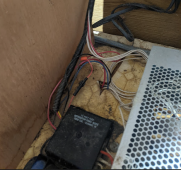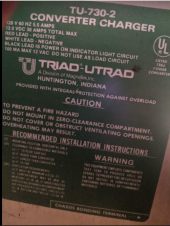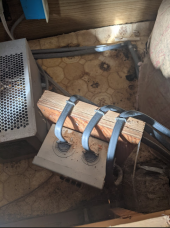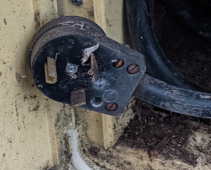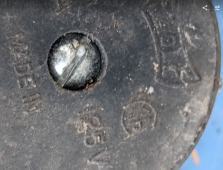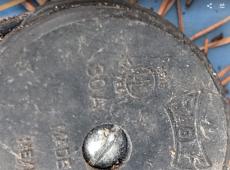timselectric
If I can do it, you can do it.
- Joined
- Feb 5, 2022
- Messages
- 18,380
Triplex, ran through the trees. Would be the easiest and cheapest option.
Woah I didn't realize that there were 2 wires there that's amazing! And no conduit would make my life far easier, I'll definitely be getting this thank you so much, you just saved me about $300.With aluminum, you need to go up one size for the rated amperage.
Don't forget to include the cost of conduit.
URD doesn't require a conduit.
Also, the URD includes both conductors at that per ft price.
Just saw this, what's triplex? Can you link it to me?Triplex, ran through the trees. Would be the easiest and cheapest option.
Thank @740GLE , it was his recommendation.Woah I didn't realize that there were 2 wires there that's amazing! And no conduit would make my life far easier, I'll definitely be getting this thank you so much, you just saved me about $300.
Just getting 325 feet of red and 325 feet of black? I would buy another string of panels but my all-in-one has a max of 2000 watts of solar so I'm already going to be over paneling by 13%~
Okay so I'm assuming that the third strand would be for the ground but what would I do with it? my panels would only have 2 connections for wire and my plan was just to use some basic MC4 connectors. If I don't have to bury this stuff I would happily go with it even if it's more expensive.Overhead Service Drop Cable | WireAndCableYourWay.com
Our Aluminum Overhead Service Drop Cable is cut to length and sold by the foot. Our selection features various sizes of duplex, triplex, and quadruplex cable.www.wireandcableyourway.com
Okay that all seems simple enough, I'm doing this for a camper trailer so there isn't a main ground bar, would buying a copper ground bar from home depot and connecting it to that suffice?Ground, should be connected to the solar panel frames, and any metal racking.
On the other end, it should be connected to the AC systems main ground bar.
Hello again, yes I'll be installing it for the camper and then eventually a single-wide trailer in the far future, The goal was going to be to once I have enough batteries in panels to just essentially plug the camper into my all-in-one. I have a picture below the way the all-in-one works is you essentially attach an extension cord for your AC output so I was just going to use the plug that the camper comes with. Oh and yes it will be permenant.What are you installing for an electrical system, in the camper?
AIO and a panel?
Or one of those portable solar generators?
I'm assuming that the camper will be in this location permanently.
I'm afraid I don't really understand this part at all can you re-iterate it for me?Ground goes to chassis of camper and a ground rod.
Probably battery has negative to chassis?
Alright, that's very good to know thank you.The goal is to ensure even if PV wire shorts to chassis, chassis is never 100V above earth, a lethal hazard.
No breaker or fuse is going to interrupt it, so it will just sit with current running through wires.
Grounding PV frames also keeps the from becoming "hot" and sending current through earth.
I'm afraid I don't really understand this part at all can you re-iterate it for me?
This makes everything much clearer thank you, I don't think the camper has a battery as we've been unable to find one. The trailer is 35~ years old so I'm honestly not sure how up-to-date it is and likely doesn't have GFCI breakers. I do have pictures of all the camper's main electronics systems if that would help to figure it out.Ground wire from PV frame to ground system of camper and to a ground rod in the earth.
Typically a camper has a 12V battery with negative tied to chassis, same as a car.
AC circuits in camper have ground pin of outlets wired to electrical box an chassis.
All grounds would be electrically connected.
I think my charge controller might have this feature, the AC input has a hole for a ground wire but the AC output didn't so when they emailed them they said the whole box was grounded and there was a screw to attach your ground wire to the box. I can email them directly to find out.Some charge controllers may provide a ground-fault interrupter function. I think Midnight does this with a 3-pole breaker. Two poles are for PV+ an PV-, and a 3rd pole is 0.5A breaker and goes from PV- to ground. A fault elsewhere that causes current flowing to ground trips the breaker and disconnects PV. But that might not work with some inverters or other equipment that also had a bond from DC to ground.
Make sure his camper has GFCI breakers or outlets for all AC outlets in kitchen, bath, and outdoors.
There is a main ground bar in your entrance panel.for a camper trailer so there isn't a main ground bar,
good ideathink I'm going to bury the wire as you suggested.
There is a main ground bar - for 1985-ish it should and probably does have a ground bus, a neutral bus, and the H/black/live/line feeds the breakers. Neutral/white and bare/Ground/green should NOT be bonded in there. The N-G bond is provided from either a shorepower stanchion for grid, or in this case it is plugged in to the aio inverter output. Inverter should be bonded unless it is receiving power from a bonded generator or the grid with a 3wire connection.for a camper trailer so there isn't a main ground bar,
For a 2400W output make sure to use 10ga for fire prevention.you essentially attach an extension cord for your AC output so I was just going to use the plug that the camper comes with. Oh and yes it will be permenant.
Make sure his camper has GFCI breakers or outlets for all AC outlets in kitchen, bath, and outdoors.
Depending on the manufacturer of the camper’s entrance/breaker box, you are likely to be able to buy a GFCI breaker. 35 years old is only 1985The trailer is 35~ years old so I'm honestly not sure how up-to-date it is and likely doesn't have GFCI breakers.
Sure. Post up.I do have pictures of all the camper's main electronics systems if that would help to figure it out.
trulyWith aluminum, you need to go up one size for the rated amperage.
I'll add some pictures of the main system below, I'm not currently staying at the trailer as me and my day are currently house sitting/dog sitting but this won't last long as the dog is sadly on his way out. If you need any more pictures I'll likely be stopping by the camper within the next few days and can get all the info you might need.There is a main ground bar in your entrance panel.
There is a main ground bar - for 1985-ish it should and probably does have a ground bus, a neutral bus, and the H/black/live/line feeds the breakers. Neutral/white and bare/Ground/green should NOT be bonded in there. The N-G bond is provided from either a shorepower stanchion for grid, or in this case it is plugged in to the aio inverter output. Inverter should be bonded unless it is receiving power from a bonded generator or the grid with a 3wire connection.
I'm just about certain it's an 8 gauge wire so it should be all fine.For a 2400W output make sure to use 10ga for fire prevention.
So would wiring in a GCCI outlet means I don't need to replace the breaker because this sounds by far the easiest and simplest option?Depending on the manufacturer of the camper’s entrance/breaker box, you are likely to be able to buy a GFCI breaker. 35 years old is only 1985
Because your AIO is 2400W you can just wire in a 20A GFCI outlet and plug the RV 30A cord into that- my biggest inverter is 2000W so I could just do that and did.
If you can switch out your main breaker for a 30A GFCI breaker it might cost the same or less than doing the four or five GFCI outlets you’d otherwise need to buy. And EVERYTHING would be GFCI protected.
Pictures below! Oh, and do you think I should go with the duplex and bury the wire or do with the triplex and string it from the trees, the second option sounds easier but more complicated but I'm honestly not sure which would be better.Sure. Post up.
Your camper sounds a little unusual from my experience- like you have a ‘park model’ without any normal RV conventions.
Does it have a “converter” for a load center? Or just the breaker/entrance panel? I suspect the latter.
truly

